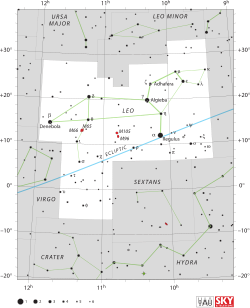Delta Leonis
| Observation data Epoch J2000 Equinox J2000 |
|
|---|---|
| Constellation | Leo |
| Right ascension | 11h 14m 06.50142s |
| Declination | 20° 31′ 25.3853″ |
| Apparent magnitude (V) | 2.56 |
| Characteristics | |
| Spectral type | A4 V |
| U−B color index | +0.12 |
| B−V color index | +0.12 |
| Variable type | Delta Scuti |
| Astrometry | |
| Radial velocity (Rv) | -20.2 km/s |
| Proper motion (μ) |
RA: +143.42 mas/yr Dec.: -129.88 mas/yr |
| Parallax (π) | 55.82 ± 0.25mas |
| Distance | 58.4 ± 0.3 ly (17.91 ± 0.08 pc) |
| Details | |
| Mass | 2.2 M☉ |
| Radius | 2.14 ± 0.040 R☉ |
| Luminosity | 15.5 ± 1.8 L☉ |
| Surface gravity (log g) | 3.91 cgs |
| Temperature | 8,296 K |
| Rotational velocity (v sin i) | 180 km/s |
| Age | 0.60-0.75 Gyr |
| Other designations | |
| Database references | |
| SIMBAD | data |
Delta Leonis (δ Leonis, abbreviated Delta Leo, δ Leo), also named Zosma, is a star in the zodiac constellation of Leo. Based upon parallax measurements, it lies at a distance of about 58.4 light-years (17.9 parsecs) from the Sun.
Zosma is a relatively ordinary main sequence star with a stellar classification of A4 V, making it is somewhat larger and hotter than the Sun. It is a fairly well-studied star, allowing relatively accurate measurements of its age and size. The radius of the star, as measured directly using an interferometer, is about 214% of the Sun's radius and it is emitting more than 15 times as much luminosity as the Sun. The energy is being emitted from the outer envelope with an effective temperature 8,296 K, giving it the white hue characteristic of an A-type star. Having a larger mass than the Sun it will have a shorter lifespan, and in another 600 million years or so will swell into an orange or red giant star before decaying quietly into a white dwarf.
This star is rotating rapidly, with a projected rotational velocity of 180 km s−1. The inclination of the axis of rotation to the line of sight from the Earth is estimated at 38.1°, which would mean the azimuthal velocity along the equator is about 280 km s−1. This rotation is producing an equatorial bulge, giving the star a pronounced oblate spheroidal shape. The polar radius is about 84% of the radius along the equator.
...
Wikipedia

